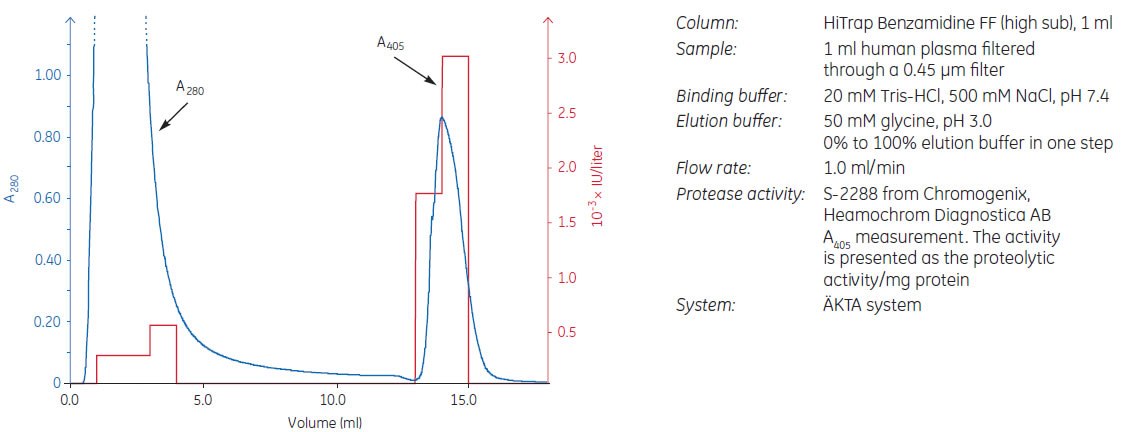Purification or Removal of Serine Proteases, such as Thrombin and Trypsin, and Zymogens
Benzamidine Sepharose 4 Fast Flow (low sub), Benzamidine Sepharose 4 Fast Flow (high sub)
Sample extraction procedures often release proteases into solution, requiring the addition of protease inhibitors to prevent unwanted proteolysis. An alternative to the addition of inhibitors is to use a group-specific AC medium to remove the proteases from the sample. The same procedure can be used to either specifically remove these proteases or purify them.
The synthetic inhibitor para-aminobenzamidine is used as the affinity ligand for trypsin, trypsin-like serine proteases, and zymogens. Benzamidine Sepharose 4 Fast Flow is frequently used to remove molecules from cell culture supernatant, bacterial lysate or serum. During the production of recombinant proteins, tags such as GST are often used to facilitate purification and detection. Enzyme specific recognition sites are included in the recombinant protein to allow the removal of the tag by enzymatic cleavage when required. Thrombin is commonly used for enzymatic cleavage, and must often be removed from the recombinant product. HiTrap® Benzamidine FF (high sub) provides a simple, ready-to-use solution for this process.
Figure 3.21 shows the partial structure of Benzamidine Sepharose 4 Fast Flow and Table 3.25 gives examples of different serine proteases. Benzamidine Sepharose 4 Fast Flow (high sub) is a medium designed for high capacity. It has a trypsin binding capacity greater than 35 mg/mL medium. For some applications, Benzamidine Sepharose 4 Fast Flow (high sub) induces strong interactions between ligand and target molecules, which may lead to reduced purity and recovery. Benzamidine Sepharose 4 Fast Flow (low sub) is designed to balance good capacity with high purity and recovery.

Figure 3.21.Partial Structure of Benzamidine Sepharose 4 Fast Flow.
Chromatography Media Characteristics
Characteristics of Benzamidine Sepharose chromatography media are shown in Table 3.26.
1 Short term refers to the pH interval for regeneration, cleaning-in-place, and sanitization procedures. Long term refers to the pH interval over which the medium is stable over a long period of time without adverse effects on its subsequent chromatographic performance.
Purification options
Benzamidine Sepharose 4 Fast Flow low and high sub chromatography media and prepacked columns are described in Table 3.27.
1 See Appendix 4 to convert flow velocity (cm/h) to volumetric flow rate (mL/min). Maximum operating flow is calculated from measurement in a packed column with a bed height of 10 cm and i.d. of 5 cm.
2 Supplied in 50 mM acetate, pH 4.0 containing 20% ethanol.
Purification examples
Figure 3.23 shows an example of the removal of trypsin-like proteases from human plasma to prevent proteolysis of the plasma components, using a low pH elution. The activity test demonstrated that almost all trypsin-like protease activity is removed from the sample and bound to the column.

Figure 3.22.Removal of trypsin-like serine proteases from human plasma using HiTrap® Benzamidine FF (high sub), 1 mL.
Figure 3.23 shows the effectiveness of using a GSTrap™ FF column with a HiTrap® Benzamidine FF (high sub) for purification of a GST-tagged protein, followed by cleavage of the GST tag via the thrombin cleavage site and subsequent removal of the thrombin enzyme. The GST-tagged protein binds to the GSTrap™ FF column as other proteins wash through the column. Thrombin is applied to the column and incubated for 2 h.
A HiTrap® Benzamidine FF (high sub) column, pre-equilibrated in binding buffer, is attached after the GSTrap FF column and both columns are washed in binding buffer followed by a high salt buffer. The cleaved protein and thrombin wash through from the GSTrap™ FF column, thrombin binds to the HiTrap® Benzamidine FF (high sub) column, and the eluted fractions contain pure cleaved protein.

Figure 3.23.On-column cleavage of a GST-tagged protein and removal of thrombin after on-column cleavage, using GSTrap FF and HiTrap® Benzamidine FF (high sub).
Performing a Separation
Binding buffer: 50 mM Tris-HCl, 500 mM NaCl, pH 7.4
Elution buffer alternatives:
- pH elution: 50 mM glycine-HCl, pH 3.0 or 10 mM HCl, 50 mM NaCl, pH 2.0
- competitive elution: 20 mM p-aminobenzamidine in binding buffer
- denaturing eluents: 8 M urea or 6 M guanidine hydrochloride
- Equilibrate the column with 5 CV of binding buffer.
- Apply the sample.
- Wash with 5 to 10 CV of binding buffer or until no material appears in the eluent (monitored by UV absorption at A280 nm).
- Elute with 5 to 10 CV of elution buffer. Collect fractions in neutralization buffer if low pH elution is used1. The purified fractions can be buffer exchanged using desalting columns (see Buffer exchange and desalting, Appendix 1).
1 Since elution conditions are quite harsh, collect fractions into neutralization buffer (60 to 200 µL of 1 M Tris-HCl, pH 9.0 per milliliter of fraction), so that the final pH of the fractions will be approximately neutral.
Since Benzamidine Sepharose 4 Fast Flow has some ionic binding characteristics, the use of 500 mM NaCl and pH elution between 7.4 and 8.0 is recommended. If lower salt concentrations are used, include a high salt wash step after sample application and before elution.
The elution buffer used for competitive elution has a high absorbance at 280 nm. The eluted protein must be detected by other methods, such as an activity assay, total protein or SDS-PAGE analysis. The advantage with competitive elution is that the pH is kept constant throughout the purification.
Cleaning
Wash with 3 to 5 CV of 100 mM Tris-HCl, 500 mM NaCl, pH 8.5 followed with 3 to 5 CV of 100 mM sodium acetate, 500 mM NaCl, pH 4.5 and re-equilibrate immediately with 3 to 5 CV of binding buffer. Remove severe contamination by washing with nonionic detergent such as 0.1% Tween 20 at 37 °C for 1 min.
Chemical Stability
All commonly used aqueous buffers.
Storage
Wash chromatography media and columns with 20% ethanol in 50 mM sodium acetate, pH 4.0 (use approximately 5 CV for packed media) and store at 4 °C to 8 °C.
如要继续阅读,请登录或创建帐户。
暂无帐户?